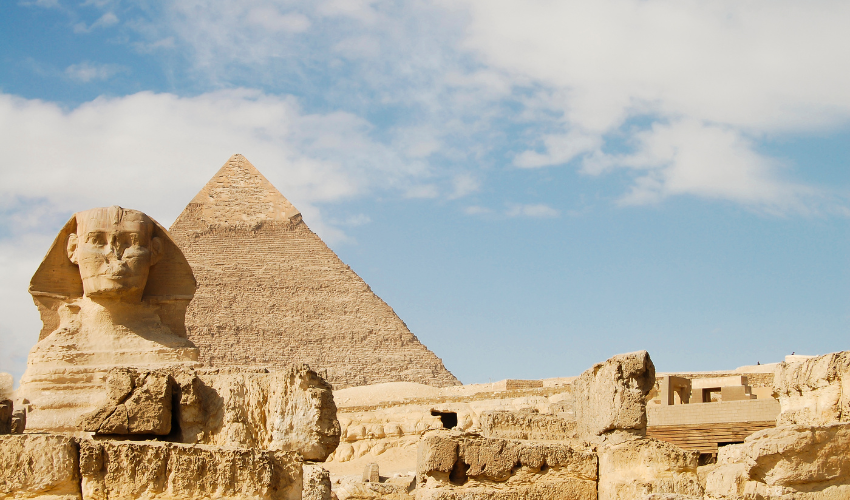The pyramids of Egypt are among the most recognizable and iconic structures in the world. These towering structures have captured our imaginations for centuries, and to this day, we continue to marvel at the engineering feats achieved by ancient Egyptians. But beyond their awe-inspiring size and design, the pyramids hold many mysteries and interesting facts that most people are not aware of.
In this article, we will take a closer look at the facts about pyramids of Egypt, including how they were built, their purpose, and the people behind them.

Construction
One of the most impressive things about the pyramids is the construction process itself. The pyramids were built using a combination of brute force and clever engineering. The workers used ramps to move the massive blocks of limestone, which could weigh several tons each. They used simple machines, such as levers and pulleys, to move the blocks into place. The workers also used copper chisels and stone tools to carve the blocks and shape them into the precise shapes needed to create the pyramid. It took around 20 years to construct the Great Pyramid of Giza, which is one of the largest pyramids in Egypt.
The workers who built the pyramids were not slaves, as many people believe. Archaeologists have discovered evidence of housing, food, and medical care for the workers who built the pyramids. Many of the workers were probably farmers who worked on the pyramids during the off-season when their fields were not being cultivated.
Purpose
The pyramids were built to serve as the final resting place of pharaohs and their consorts. The ancient Egyptians believed that the pharaohs needed everything they had in life to carry over into the afterlife. This included their possessions, servants, and even their bodies. The pharaohs were mummified and placed in elaborate tombs that were filled with all the things they would need in the afterlife, including food, clothing, and furniture.
The pharaohs were not the only ones who were mummified and buried in pyramids. Many of the pharaohs’ consorts, as well as other members of the royal family, were also buried in pyramids. Some of the pyramids were also used to house the bodies of important officials and their families.

Alignment with the stars
The alignment of the pyramids with the stars is one of the most fascinating facts about pyramids of Egypt. The ancient Egyptians believed that the pharaohs’ souls needed to ascend to the heavens to reach the afterlife. The alignment with the stars helped guide the pharaohs’ souls to the afterlife. The pyramids were aligned with the North Star, which was believed to be the home of the god Osiris, who was associated with the afterlife.
The Great Pyramid of Giza is aligned with incredible precision. It is aligned with true north to within a fraction of a degree, which is a remarkable achievement considering that the ancient Egyptians did not have access to modern tools such as GPS.
Religion
Religion played a significant role in the construction of the pyramids. The ancient Egyptians had a complex system of gods and goddesses, many of whom were associated with the afterlife. They believed that the pharaohs needed to be buried with all their possessions so they could take them with them into the afterlife.
One of the most important gods in the ancient Egyptian pantheon was Ra, the sun god. The pharaohs were believed to be the sons of Ra. They were often depicted as such in art and sculpture. The pharaohs were also associated with the god Horus, who was believed to be the son of Osiris, the god of the afterlife.
Looting and damage
Despite their massive size and impressive construction, the pyramids were not always safe from looters and robbers. Many of the pyramids were plundered in ancient times, and the treasures that were meant for the pharaohs were stolen. This has been happening since ancient times. The robbers realized that there were hidden chambers inside the pyramids where treasures were stored.
Another problem that the pyramids face is damage caused by natural causes and modern humans. Over the centuries, the sand and wind have worn away at the outer layers of the pyramids, causing them to lose some of their original sheen. Additionally, there have been instances where people have caused damage to the pyramids by climbing on them or carving their names into the stone. As a result, there have been many efforts to preserve the pyramids and prevent further damage.
Bullet Points
The Purpose of the Pyramids
- The pyramids were built to serve as the final resting place of pharaohs and their consorts.
- The ancient Egyptians believed in an afterlife and thought the pharaohs needed everything they had in life to carry over into the afterlife.
- The pyramids were built to align with the stars, which helped the pharaohs’ souls ascend to the heavens.
The Construction of the Pyramids
- The three pyramids of Giza were built for Khufu, Khafre, and Menkaure.
- The pyramids were built using limestone, granite, and basalt.
- The ancient Egyptians used simple tools and techniques, such as levers, ramps, and pulleys, to move the heavy stones.
The People Behind the Pyramids
- The pharaohs were the driving force behind the construction of the pyramids.
- The architects and engineers designed the pyramids and oversaw their construction.
- The workers who built the pyramids were mostly skilled laborers who were well-compensated for their work.
The Legacy of the Pyramids
- The pyramids have had a significant influence on architecture throughout history.
- The pyramids are a major tourist attraction and source of income for Egypt.
- Pyramids were built in other parts of the world, such as in Mesoamerica and China.
FAQs
Why were the pyramids built?
The pyramids were built to serve as the final resting place of pharaohs and their consorts. The ancient Egyptians believed in an afterlife and thought the pharaohs needed everything they had in life to carry over into the afterlife.
How were the pyramids constructed?
The ancient Egyptians used simple tools and techniques, such as levers, ramps, and pulleys, to move the heavy stones.
Who built the pyramids?
The pyramids were built by skilled laborers who were well-compensated for their work. Many of the workers were probably farmers who worked on the pyramids during the off-season when their fields were not being cultivated.
How long did it take to build the pyramids?
It took approximately 20 years to build the Great Pyramid of Giza.
What is the significance of the alignment of the pyramids with the stars?
The ancient Egyptians believed that the pharaohs’ souls needed to ascend to the heavens to reach the afterlife. The alignment with the stars helped guide the pharaohs’ souls to the afterlife.
Conclusion
The pyramids of Egypt remain an enigma to modern-day society, despite extensive study and research. The pyramids stand as a testament to the incredible engineering skills and creativity of the ancient Egyptians. The facts about pyramids of Egypt, including their purpose, construction, and the people behind them, continue to fascinate and intrigue people worldwide. As a symbol of ancient Egyptian culture and achievement, the pyramids will always be a source of wonder and inspiration for generations to come.






















